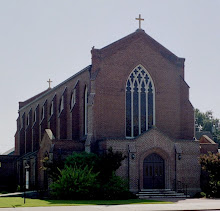Acts 59:1-20 Psalm 30
It is more than simply their length or context which sets apart the post-resurrection narratives surrounding food in Luke from that in John. John’s is of a markedly different character. The Lukan ones clearly are about revealing something as to the nature of Christ’s presence among his disciples, as well as the absolute reality of the bodily resurrection. In the first, the evangelist is trying to depict how Christians will now come to recognize Jesus’ continuing presence among them in the Holy Eucharist: “When [Jesus] was at the table with them, he took bread, blessed and broke it, and gave it to them. Then their eyes were opened, and they recognized him.” (Luke 24:30-31a) In the second, the writer seeks to show the corporeal reality of the resurrrection, more specifically that Jesus is not simply a ghost or spirit: “He said to them, ‘Why are you frightened, and why do doubts arise in your hearts? Look at my hands and my feet; see that it is I myself. Touch me and see; for a ghost does not have flesh and bones as you see that I have.’ ” (Luke 24:38-39) On the other hand, John’s narrative of Jesus’ lakeside breakfast feels far more nuanced and intricately woven. Instead of trying to prove the reality of the resurrection or the identity of Jesus as the one among them, the story in John points to the life of the Church beyond these realities. Most certainly the Johaninne story is also about bodily reality, but that body is the Body of Christ – the Church revealed through Christ himself, and entrusted to his followers for its further growth and revelation.
The narrative in John is actually comprised of three inter-related incidents: a fishing party among the disciples, the lakeside breakfast previously alluded to, and Peter’s re-commitment to his love for and belief in Jesus. These are not merely stories written to convince their readers as to the truth of the resurrection, they were not written to inspire or confirm belief, rather what they seem written to indicate a pattern of living and growth for the early Church. The first story hearkens back to Jesus’ initial calling of the disciples, but at the same time points to the gathering together of God’s people by the labor and efforts of those same disciples. While they are not successful in their first attempt, they are subsequently – following the directions of Jesus – extremely successful. They gather in so many fish that it tests the strength of the net. Nevertheless, the net is not torn, and the disciples are able to haul it full onto the shore. There Jesus invites them to a meal, a meal which carries resonances of previous ones in the Gospels, most especially those in which multitudes are fed with scant provisions. This meal, as the center of the narrative also forms its pivotal part, as the disciples affirm the presence of Jess among them, “they knew it was the Lord.” Finally, following the meal Jesus, commissions Peter (and by extension all his followers) to prove his love for him by feeding his sheep, tending to the world’s needs. The three little episodes each signify different and specific stages in Christian growth and mission: gathering, celebration, sharing. God gathers a people; together they learn to celebrate their identity as God’s people, but also the reality of God’s continuing presence among them; and from this celebration and because of this presence they go into the world to share and provide possibilities of celebration to others.
Now, I will be the first to admit that our culture has perhaps the most unhealthy and most bizarre relationhship with food and eating than any before it. Nevertheless, the images presented to us in John’s narrative are are helpful and telling, especially coming as they do after Lent, a period a fasting. They remind us that we are in a time of feasting. Alleluia, Christ is risen, and we are called to celebrate that. We celebrate it with food certainly, but with fellowship both at and away from the Eucharistic table. We celebrate by not fasting, either in body or spirit. At the same time, we cannot keep the celebration and feasting to ourselves. We are called also to provide for others, welcome and draw others through Christ’s love and presence into the celebration, into the feast. The abundance is there, and we are invited to let it overflow. While Luke’s post-ressurection narratives seem to be about proving the resurrection’s reality, John’s seem to be about living the resurrection’s reality; and food and eating seemed the best metaphors for expressing that.
Of course, Jesus was not an Episcopalian; and yet as presented here in John he does seem to exemplify some pretty basic Episcopal qualities. As John uses the post-resurrection stories to teach his fellow Christians how to live out their new life in Christ, we find a Jesus who affirms the reality of fellowship and of food, who values cooperation and conviviality. We see a Jesus not afraid to embrace and enjoy life. At the same time we see a Jesus who is commited and who commits his followers to going beyond the demarcations of their group. We see and Jesus who states quite clearly that feeding one’s self or one’s own is only part of the celebration: “If you love me, feed my sheep” (cf. John 21:14-17), and that is very Episcopal too.
The writer of John presents for us this pattern of Chrisitian life, of post resurection living: gathering, celebration, and sharing as the pattern for post-resurrection living. Gather, celebrate, share. It is the agenda of the kingdom. It is the agenda of the resurrection. It ought be the agenda of evey Christian, Episcopalian or otherwise.




No comments:
Post a Comment